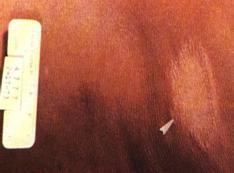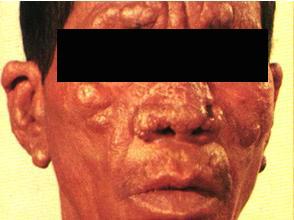Leprosy is a slowly progressing bacterial infection caused by Mycobacterium leprae that affects the skin, nerves in the arm and leg, and other organs such as nose and eyes.
Leprosy is also known as Hansen’s disease.
The mode of spread is uncertain but it is thought to be the respiratory droplets from an infected person to another person. Environmental factors such as unhygienic and crowded living conditions contribute to the spread of the disease. Malnutrition and a weak immune system also favour infection.
The incubation period is very long varying from 1 year to 40 years. The disease strikes mainly young people between 10 to 20 years of age, males more often than females.
Leprosy is endemic in Malaysia but the incidence is low .
Signs and Symptoms
There are 2 types of leprosy
- Paucibacillary (- negative slit skin smear)
One or a few red or white patches with no itchiness or pain. Rough and dry affected skin with no sweat and no hair growth. If left untreated it may become more widespread.

- Multibacillary leprosy (- positive slit skin smear )
Multiple red patches at any sites of the body. Early skin patches can be seen on the ears and face. This type is infectious if not treated and can cause deformity.

In an endemic area, if smears from an individual show the presence of Acid Fast Bacilli, or if he has typical skin lesions, he should definitely be regarded as having leprosy. Usually, there is slight discoloration of the skin and loss of skin sensitivity. Thickened nerves accompanied by weakness of muscles supplied by the affected nerve are very typical of the disease. One characteristic occurrence is a foot drop where the foot cannot be moved upwards, affecting the ability to walk.
Complications
Deformities on the face include flatten nose bridge, and loss of eyebrows and eyelashes
Deformities on hand include loss of palm muscles, resulting in bent fingers, weakness of the hands with loss of hand functions.
Deformities of the leg include loss of sensation over the toes and in late stages, ulceration of the soles near the toes.
|
|
|
Loss of eyesight
Treatment
Leprosy is a curable disease, and treatment provided in the early stages averts disability. All patients must follow the treatment regime as to avoid deformity. World Health Organization (WHO) recommended multidrug therapy (MDT). MDT consists of three drugs: dapsone, rifampicin and clofazimine for multibacillary. For paucibacillary they will receive dapsone and rifampicin. This drug combination kills the pathogen and cures the patient. Upon completion of treatment, followed up for 5 years for paucibacillary and 15 years for multibacillary annually.
Prevention
By early diagnosis and appropriate treatment of infected individuals, leprosy can be controlled. Prevention consists of avoiding close physical contact with untreated people. People who are in immediate contact with the leprosy patient should be tested for leprosy. Annual examinations should also be conducted on these people for a period of five years following their last contact with an infectious patient
Rehabilitation
The deformities and nerve damage associated with leprosy are often irreversible. Preventions or rehabilition of these defects is an integral part of management of the disease. Reconstructive surgery is aimed at preventing and correcting deformities. Comprehensive care involves teaching patients to care for themselves. If the patients have significant nerve damage or are at high risk of developing deformities, they must be taught to take care of their insensitive limbs, similar to diabetics with lower leg nerve damage. Lacking the sensation of pain, the patients should constantly check themselves to identify cuts and bruises. Physiotherapy exercises are taught to the patients to maintain a range of movement in finger joints and prevent the deformities from worsening. Prefabricated standardized splints are available and are extremely effective in correcting and preventing certain common deformities in leprosy. Special kinds of footwear have been designed for patients with insensitive feet in order to prevent or minimize the progression of foot ulcers.
Support Groups
Call your health care provider if signs or symptoms described here occur, especially following exposure.
MALRA – Malaysian Leprosy Relief Association
Bangunan Tan Sri T H Tan
D1-01, Jalan SS6/20A, Dataran Glomac
Kelana Jaya, 47301, Petaling Jaya
Tel : 03-78802607, 78802608
Fax : 03-78802609
E mail : mleprosy@streamyx.com
Contact Person : Ms Irene Yap, Administrative Administration
| Last reviewed | : | 28 August 2020 |
| Writer | : | Dr. Fuad Hashim |
| Reviewer | : | Dr. Nor Faizah bt. Ghazali |







